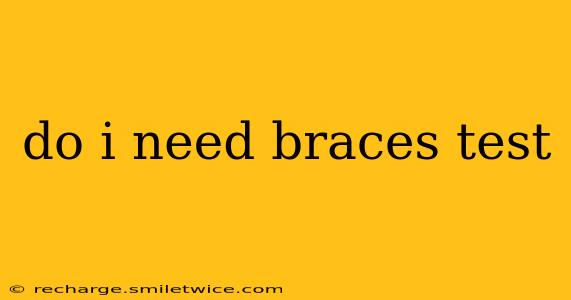Do I Need Braces? A Comprehensive Guide to Orthodontic Assessment
Considering braces? It's a big decision, impacting both your appearance and oral health. This guide will help you determine if braces are right for you, addressing common concerns and outlining the assessment process.
What are the signs I might need braces?
Many factors contribute to the need for orthodontic treatment. Some are easily visible, while others require a professional evaluation. Common indicators include:
- Overcrowding: Teeth are too tightly packed, leading to crookedness and potential difficulty cleaning.
- Spacing: Gaps between teeth, affecting aesthetics and potentially impacting bite function.
- Crossbite: Upper teeth bite inside the lower teeth, or vice versa, potentially leading to jaw problems.
- Underbite: Lower jaw protrudes significantly beyond the upper jaw.
- Overbite: Upper jaw significantly overlaps the lower jaw.
- Open bite: A gap between the upper and lower teeth when biting down.
- Difficulty chewing or biting: This could indicate a misalignment affecting jaw function.
- Jaw pain or clicking: This might signify temporomandibular joint (TMJ) disorder, sometimes linked to bite problems.
- Speech impediments: Certain misalignments can affect articulation.
- Increased risk of gum disease or tooth decay: Crowded teeth are harder to clean, increasing susceptibility to these problems.
What happens during a braces consultation?
A thorough orthodontic assessment is crucial to determine the necessity and type of treatment. Expect the following during your consultation:
- Medical history review: Your orthodontist will review your overall health, past dental work, and any relevant family history.
- Oral examination: A visual inspection of your teeth, bite, and jaw alignment.
- X-rays: To provide a detailed view of tooth roots, jaw structure, and any underlying issues.
- Dental impressions: Creating models of your teeth to assess the bite and plan treatment.
- Photographs: To document the initial condition of your teeth and jaws.
- Discussion of treatment options: Based on the assessment, your orthodontist will discuss various options, including braces, Invisalign, or other appliances, and their potential benefits and drawbacks.
How much do braces cost, and are there payment options?
The cost of braces varies significantly depending on the complexity of the treatment, the type of braces used, and your geographical location. Many orthodontists offer payment plans to make treatment more affordable. It's essential to discuss payment options and explore any potential insurance coverage during your consultation.
What is the difference between metal braces and Invisalign?
Metal braces and Invisalign are both effective orthodontic treatments, but they differ in appearance and mechanism. Metal braces use brackets and wires to gradually move teeth into proper alignment. Invisalign utilizes a series of clear aligners, offering a more discreet option. Your orthodontist will help determine which option is best suited to your individual needs and preferences.
How long does braces treatment typically take?
The duration of braces treatment varies depending on the severity of the misalignment and individual response to treatment. Treatment can range from a few months to several years. Your orthodontist will provide a more accurate estimate after your initial assessment.
Can I get braces as an adult?
Absolutely! While many associate braces with adolescents, orthodontic treatment is highly effective for adults as well. Adult teeth can be successfully moved, improving both aesthetics and oral health.
What are the benefits of getting braces?
The benefits of orthodontic treatment extend beyond aesthetics. They include:
- Improved chewing and biting: Correcting bite problems can make eating easier and more efficient.
- Reduced risk of gum disease and tooth decay: Straight teeth are easier to clean, promoting better oral hygiene.
- Enhanced self-confidence: A straighter smile often boosts self-esteem.
- Improved jaw function: Addressing jaw misalignments can alleviate jaw pain and TMJ disorders.
- Improved speech: In some cases, orthodontic treatment can resolve speech impediments.
In conclusion, whether or not you need braces depends entirely on your individual circumstances. The best way to find out is to schedule a consultation with an orthodontist. They will conduct a comprehensive assessment to determine if orthodontic treatment is necessary and, if so, recommend the most appropriate approach.
